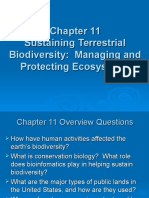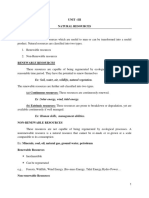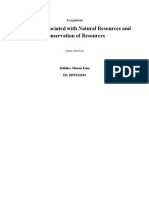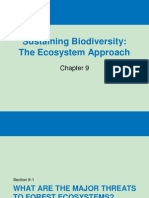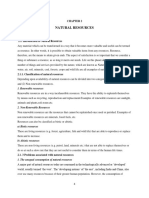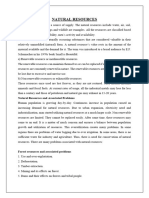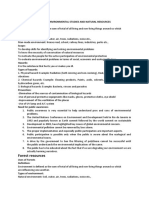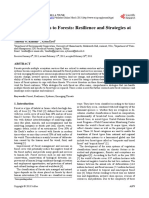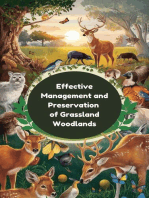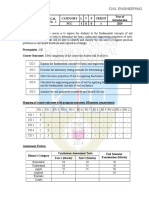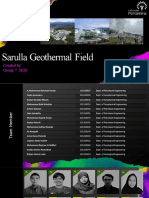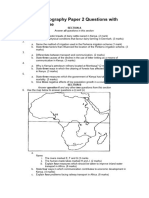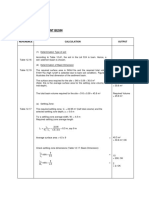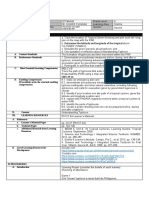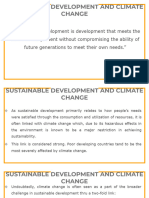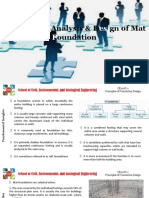Chap 11 Outline: Sustaining Terrestrial Biodiversity: Managing and Protecting Ecosystems. 11.1 Human Impacts On Terrestrial Biodiversity
Chap 11 Outline: Sustaining Terrestrial Biodiversity: Managing and Protecting Ecosystems. 11.1 Human Impacts On Terrestrial Biodiversity
Uploaded by
Jorge AltoSax GonzalezCopyright:
Available Formats
Chap 11 Outline: Sustaining Terrestrial Biodiversity: Managing and Protecting Ecosystems. 11.1 Human Impacts On Terrestrial Biodiversity
Chap 11 Outline: Sustaining Terrestrial Biodiversity: Managing and Protecting Ecosystems. 11.1 Human Impacts On Terrestrial Biodiversity
Uploaded by
Jorge AltoSax GonzalezOriginal Title
Copyright
Available Formats
Share this document
Did you find this document useful?
Is this content inappropriate?
Copyright:
Available Formats
Chap 11 Outline: Sustaining Terrestrial Biodiversity: Managing and Protecting Ecosystems. 11.1 Human Impacts On Terrestrial Biodiversity
Chap 11 Outline: Sustaining Terrestrial Biodiversity: Managing and Protecting Ecosystems. 11.1 Human Impacts On Terrestrial Biodiversity
Uploaded by
Jorge AltoSax GonzalezCopyright:
Available Formats
Chap 11 Outline: Sustaining Terrestrial Biodiversity: Managing and Protecting Ecosystems. 11.
1 Human Impacts on Terrestrial Biodiversity -Human activities have depleted and degraded some the earths biodiversity and these threats are expected to increase. 1) Fig. 11-2 lists factors that effect biodiversity 2) Fig. 11-3 lists connections between human activities and earths biodiversity. 3) Fig. 11-4 shows projected status of earths biodiversity in 2018. 5) Fig. 11-5 outlines goals, strategies and tactics for preserving biodiversity. -Biodiversity should be preserved and protected from degradation by human activities because it exists and its useful. 1) Intrinsic value: biodiversity should be preserved because it exists. 2) Instrumental Value: Biodiversity should be preserved because it has usefulness. 11-2 Conservation Biology: -Conservation biology is a multi-disciplinary science that uses rapid response strategies to stem loss and degradation of the worlds biodiversity. 1) Conservation biologists identify the most endangered and species-rich ecosystems and then teams to evaluate and make recommendations to limit the loss of biodiversity. -Bioinformatics is the applied science of managing, analyzing, and communicating biological information. It is used to provide basic biological and ecological information to help sustain biodiversity. 11-3 Public Lands in the United States: -More than a third of the land in the United States consists of publicly owned national forests, resource lands, and protected wilderness areas. 73% is found in Alaska and another 22% in western states. (Fig. 10-6) 1) National Forest System: Managed by the US forest system and are used for logging, mining, grazing, farming, recreation, hunting, fishing as well as oil and gas extraction. 2) National Resource Lands: Managed by the BLM and are used primarily for mining, oil and gas extraction and grazing. 3) National Wildlife Refuge: Managed by US Fish and Wildlife. Most areas protect habitats and breeding areas. Permitted activities include hunting, fishing, trapping, logging, grazing, mining, oil and natural gas development and some military activities 4) National Park System: Managed by the National Park Service (NPS) and is stricter with it uses. Areas include monuments, battle fields, historic sites, trails, rivers, seashores, and other recreation areas. Only camping, fishing, hiking, and boating can take place in these areas.
-Since the 1800s there has been controversy over how US public lands should be used because of the valuable resources they contain. Arguments for both sides on page 199. 11-4 Managing and Sustaining Forests: -Some forests have not been disturbed by human activities for several hundred years, other have grown back after being cut, and some consist of planted stands of particular tree species. 1) Forests provide many economic and ecological services. (Fig. 11-7) 2) Old growth forests: Uncut forest or regenerated forests that have not been disturbed by human activities or natural disasters for several years. (22%) 3) Second growth forests: A stand of trees resulting from secondary succession. They develop after previous trees have bee removed by human activities or natural disaster. (63%) 4) Tree plantation/tree farm: A managed track of uniformly aged trees of one species that are cut or harvested as soon as they are economically valuable. (5%) -There are two types of forest management. Some forests consist of one or two species that are commercially important species that are cut down and replanted, others are contain diverse tree species harvested individually or in small groups. 1) Even aged management: Involves maintaining trees in a given stand at about the same age and size. Generally contains few fastgrowing economically desirable species. (Fig. 11-8) 2) Uneven aged management: Involves maintaining a variety of tree species at very different ages and sizes. -The first step in forest management id to build roads for access. (Fig 11.9) Once roads are in place there are various ways to remove lumber. (Fig. 11.10) 1) Selective cutting: Cutting of intermediate/mature in an uneven forest. 2) Shelterwood cutting: Removes all mature trees in an area in two or three cuttings. 3) Seed tree cutting: Remove the bulk of trees in one cutting leaving a few uniformly distributed seed producing trees to regenerate the forest. 4) Clear cutting: Removal of all trees from an area in one cutting. 5) Strip cutting: Clear cutting of strips of land in a area separated by an interval of time that allows for regeneration. 6) Fig11-11 discusses pros and cons of clear cutting -Deforestation is the temporary or permanent removal of large expanses of forests for agriculture or other uses. 1) This can provide large immediate economic services. 2) It can also reduce biodiversity, and can contribute to global and regional climate changes. (Fig. 11-12)
-Human activities have reduced the worlds forest cover by 20-50% and deforestation is continuing at an alarming rate except in the temperate forests of North America and Europe. -Currently forests are mostly valued for their economic services, however the ecological services provided by the worlds forests are rarely used when decisions are made about their uses. The economic value of the ecological services we get is estimated at 36 trillion dollars/year. -We can use forests more sustainably by including the economic value of their ecological services, harvesting trees no faster than they can replenish and protect old growth forests and vulnerable areas. (Fig. 11-13) -Some organizations have developed standards for certifying that timber has been harvested sustainably. 1) Timber harvesters have used selective cutting practices to ensure sustainability. 2) Producers and sellers of wood products have agreed to only buy and sell wood that has been certified as being sustainably from an independent group. 11-5 Forest Resources and Management in the US -US forests cover more area today than they did in 1920, more wood is grown each year than is cut and the country has set aside large areas of forest that are protected. -There is serious damage being done to US forests by non-native species. (Fig.11-14) 1) Tree damage can reduced by inspecting more imported timber, removing infected trees, and using chemicals and natural predators to help control insects and pests. -Forests fires can burn away flammable underbrush and small trees, burn large trees and leap from treetop to treetop, or burn flammable materials underground. They are separated into three types. 1) Surface fires: Generally only burn undergrowth and leaf litter. These fires spare most mature trees and allow most animals to escape. a. Surface fires can have a number of ecological benefits such as burning away ground materials and help to prevent more destructive fires. b. Help to release valuable nutrients and stimulate new growth. c. Control pathogens and insects. 2) Crown fires: Generally start on the ground but move up trees and eventually start to jump from treetop to treetop burning down entire trees. a. Generally occur in areas that have not had any surface fires for very long periods of time b. These fires can be very damaging to ecosystems. 3) Ground fires: Burn partially decayed leaves or peat and can smolder for weeks without detection.
-Fire damage can be reduced by setting controlled surface fires to prevent the build-up of surface litter. Allowing fires on public land to burn unless they are threat to human structures or life and by clearing small areas around building and places that are at a high risk. -Case study: There is controversy over whether US national forests should be managed primarily for timber, their ecological services, recreation value, or mix of all three. -Almost 2/3 of the wood consumed in the US is wasted, and much of the paper we use could be made from other sources. 1) The best way to reduce the number of trees that are harvested is to become more efficient with the wood that we use. 2) By making paper with fiber that does not com from trees, the pressure put on forests could also be reduced. 11-6 Tropical Deforestation: -Tropical forests cover about 6% of the earths land area. -More than half of the worlds terrestrial species live in tropical rainforests. -Large areas of ecological and economically important tropical forests are being cleared and degraded at a fast rate. 1) Without immediate aggressive action studies indicate that the rainforests of the Amazon basin will largely disappear in the next 50 years. -The rate at which tropical forests are disappearing is highly debated due to three reasons. 1) Difficulty in interpreting satellite images 2) Some countries hide or exaggerate deforestation rates for political reasons. 3) Governments and other agencies define, forest, deforestation and degradation in different ways. -Cutting old growth tropical forests may be causing many ecological and economic problems. Medicine and global warming. (Fig. 11-17) -The primary causes of tropical deforestation and degradation are population growth, poverty, environmentally harmful government subsidies, debts owed to developed countries and failure to value ecological services. -There are a number of ways to slow and reduce the deforestation of tropical forests. 1) Help settlers learn how to practice small scale sustainable agriculture. 2) Harvest only the renewable resources found in the forests 3) Debt for nature swaps/ 4) Develop and international system to certify that all tropical lumber has been harvested sustainably. 5) Use gentler methods to remove trees. -Solutions. The neem tree. 11-7 National Parks
-Countries world wide have established more than 1100 national parks, but most of them are threaten by human activities. 1) Only 1% of the national parks in developing countries are protected 2) A large number of parks are not large enough to sustain large animal species. 3) Invasive and nonnative species have detrimental effects. -Case study: National parks in the US 11-8 Nature Reserves -Most ecologists and conservation biologists believe that the best way to preserve biodiversity through world-wide network of protected areas. -About 7% of the worlds land has been protected and a lot of this is in the artic tundra and deserts. -Conservation biologists are calling for protection of atleast 20% of the worlds land through cooperative ventures by governments, businesses and private conservation groups. -Most developers oppose this idea -Case study: What has Costa Rica done to protect its land. -The nature conservancy has used private and corporate donations to create the worlds largest system of private natural areas and wildlife sanctuaries. 1) Created in 1951 with more than 1 million members the nature conservancy has used money to buy ecologically important pieces of land threatened by development or other human activities. -Large reserves are generally the best way to protect biodiversity, but some places several well placed, medium sized, and isolated reserves work better. -A mixture of large and small reserves may be one the best ways to protect a variety of species and communities against a large number of different threats. -Biosphere reserves have and inner protected core surrounded by two buffer zones that can be used by local people for sustainable extraction of resources for food and fuel. (Fig 11-22) -Managing and sustaining a nature reserve are affected by a variety of biological, cultural, economic and political factors. Their make-up is often determined by political, legal and economic factors that depend on land ownership and conflicting public demands. 1) One way to deal with all these uncertainties is through Adaptive ecosystem management. Made of 4 principles. a. Integrated ecological, economic and social principles to maintain biodiversity while supporting sustainable economies and communities. b. Seek ways to get government agencies, private conservation organizations, scientists, business interest, and private land owners reach a consensus on land use objectives.
c. View all decisions and strategies as scientific and social experiments and use failures as opportunities for learning and improvement. d. Emphasize continuing data gathering, monitoring, reassessment, adaptation, and innovation for further improvement. -We can prevent or slow losses of biodiversity by concentrating efforts on protecting hot spots where significant biodiversity is under immediate threat. (Fig. 11-24) -Wilderness is land that is legally set aside in a large enough are to prevent or minimize harm from human activist. 1) Undeveloped land primarily affected by forces of nature not man. 2) US presidents can create wilderness according to the Wilderness Act of 1964. -Case Study: How much wilderness has been protected in the US.
You might also like
- Living in The Environment 18th Edition Miller Solutions Manual Full Chapter PDFDocument40 pagesLiving in The Environment 18th Edition Miller Solutions Manual Full Chapter PDFFredMurphybgzr100% (20)
- APES Chapter 11 PowerpointDocument49 pagesAPES Chapter 11 PowerpointAnonymous tbJUb0BNo ratings yet
- Get Living in the Environment 18th Edition Miller Solutions Manual free all chaptersDocument49 pagesGet Living in the Environment 18th Edition Miller Solutions Manual free all chaptersronjostaneNo ratings yet
- Lecture 2.1.7 and 2.1.8Document13 pagesLecture 2.1.7 and 2.1.8hr8214120No ratings yet
- Natural ResourcesDocument8 pagesNatural Resourcessandhyarani beheraNo ratings yet
- Lecture-2 Forest ResourcesDocument5 pagesLecture-2 Forest Resourcesrajprashant13939No ratings yet
- Notes On Natural ResourcesDocument18 pagesNotes On Natural Resourcesarjit KumarNo ratings yet
- Forest and Their Conversation - AAHILDocument12 pagesForest and Their Conversation - AAHILmdaahil534No ratings yet
- EVS - Unit 1 - Natural ResourceDocument41 pagesEVS - Unit 1 - Natural Resourcer1u2No ratings yet
- DeforestationDocument3 pagesDeforestationsgrc9795No ratings yet
- UNIT 1Document15 pagesUNIT 1mshivanisri786No ratings yet
- Resources 2Document71 pagesResources 2kashishsehrawat2adNo ratings yet
- Deforestation Causes, Effects, and SolutionsDocument3 pagesDeforestation Causes, Effects, and Solutionspolash.tscNo ratings yet
- Module 4 Natural ResourcesDocument7 pagesModule 4 Natural ResourcesKarl angelo LorzanoNo ratings yet
- 1034-Assignment 2Document7 pages1034-Assignment 2হুমায়রা জাহানNo ratings yet
- Unit 2 - Environmental - Science - Study NotesDocument30 pagesUnit 2 - Environmental - Science - Study NotesArushi SinghalNo ratings yet
- B.A 4 Semester Paper-4016 Environmental Geography and Disaster ManagementDocument13 pagesB.A 4 Semester Paper-4016 Environmental Geography and Disaster Managementayaankhan3107No ratings yet
- Environmental Studies & Disaster Management: Course InstructorDocument7 pagesEnvironmental Studies & Disaster Management: Course InstructorImtiyaz KhanNo ratings yet
- Module 3 - Environmental PolutionDocument2 pagesModule 3 - Environmental Polutionjeric ranocoNo ratings yet
- 02 ManagingDocument4 pages02 ManagingjillysillyNo ratings yet
- National 4-H Forestry Quiz Bowl and Exam Study Guide: Forest Understandings and FactsDocument19 pagesNational 4-H Forestry Quiz Bowl and Exam Study Guide: Forest Understandings and Factsdhufeeraa jawar AliNo ratings yet
- 1.title The Enchanting World of ForestDocument2 pages1.title The Enchanting World of ForestromohacNo ratings yet
- Sustaining Terrestrial Biodiversity: The Ecosystem ApproachDocument74 pagesSustaining Terrestrial Biodiversity: The Ecosystem ApproachAnonymous tbJUb0BNo ratings yet
- Term Paper (Forest Conservation)Document10 pagesTerm Paper (Forest Conservation)rajeev KumarNo ratings yet
- BRYAN J. DENULAN Module-3 ENVIRONMENTAL POLLUTIONDocument2 pagesBRYAN J. DENULAN Module-3 ENVIRONMENTAL POLLUTIONjeric ranocoNo ratings yet
- Sustaining BioDiversityDocument84 pagesSustaining BioDiversityKate BayonaNo ratings yet
- Natural ResourcesDocument38 pagesNatural ResourcesSreejith RNo ratings yet
- Essays On Forest Conservation PDFDocument11 pagesEssays On Forest Conservation PDFshaeyhameedNo ratings yet
- Environmental StudiesDocument13 pagesEnvironmental StudiesShinestNo ratings yet
- Natural ResourcesDocument6 pagesNatural ResourcesMadhurGuptaNo ratings yet
- CHAPTER 2 Natural ResourcesDocument31 pagesCHAPTER 2 Natural ResourcesFang LeoneNo ratings yet
- Position Paper - Kyle, SophiaDocument15 pagesPosition Paper - Kyle, SophiaKyle CamayaNo ratings yet
- Forests Resourc and ConsrvationDocument9 pagesForests Resourc and ConsrvationMD ALINo ratings yet
- Deforestation and Forest DegradationDocument5 pagesDeforestation and Forest DegradationAniket MishraNo ratings yet
- English Speaking-DeforestationDocument8 pagesEnglish Speaking-Deforestationikram729No ratings yet
- Unit IiDocument58 pagesUnit IiVeRuNo ratings yet
- Unit 3 Natural ResourcesDocument41 pagesUnit 3 Natural ResourcesRose vNo ratings yet
- Forest ConservationDocument16 pagesForest Conservationdelight photostateNo ratings yet
- Unit 3Document26 pagesUnit 3rajeev.sbilife78No ratings yet
- Evs Unit-IiiDocument208 pagesEvs Unit-IiishivagamingoffNo ratings yet
- ForestryDocument24 pagesForestryapi-265384677No ratings yet
- 8 Conservation of Plants and Animal Living Science SolutionDocument3 pages8 Conservation of Plants and Animal Living Science SolutionAnonymous R8ejdx0zNo ratings yet
- V2e T7Document150 pagesV2e T7Kewal BagdeNo ratings yet
- forest resourcesDocument9 pagesforest resourcesAnil BhukyaNo ratings yet
- Unit 3 Natural ResourcesDocument51 pagesUnit 3 Natural ResourcesjimwhopamNo ratings yet
- EVS Medemmongla Ao Topic Report On Forest Conservation in Alimerem - CompressedDocument4 pagesEVS Medemmongla Ao Topic Report On Forest Conservation in Alimerem - CompressednagwanamitaNo ratings yet
- 7 - The Role of DeforestationDocument2 pages7 - The Role of DeforestationMansoor AsifNo ratings yet
- Chapter IV Envi SciDocument5 pagesChapter IV Envi SciAs YangNo ratings yet
- Write The Effects of Timber Extraction On Forest & Tribal PeopleDocument42 pagesWrite The Effects of Timber Extraction On Forest & Tribal PeopleSudharshni BalasubramaniyamNo ratings yet
- Unit 1 EVSDocument11 pagesUnit 1 EVSSravan Sai YadavNo ratings yet
- Gelect3 ReviewerDocument49 pagesGelect3 Reviewer20228553No ratings yet
- Environment EcologyDocument148 pagesEnvironment Ecologychirag jalanNo ratings yet
- Management of Natural Resources - Question Bank PDFDocument7 pagesManagement of Natural Resources - Question Bank PDFRatheesh Hrishikesh100% (1)
- Unit 2Document25 pagesUnit 2BalaKrishna Batta100% (1)
- Muste ADocument11 pagesMuste AargenkiyaNo ratings yet
- Range LandDocument83 pagesRange Landmoges lakeNo ratings yet
- Test 6Document8 pagesTest 6PulkitNo ratings yet
- Emerging Threats To Forests: Resilience and Strategies at System ScaleDocument10 pagesEmerging Threats To Forests: Resilience and Strategies at System Scaleshafique ahmedNo ratings yet
- Emerging Threats To Forests: Resilience and Strategies at System ScaleDocument10 pagesEmerging Threats To Forests: Resilience and Strategies at System Scaleshafique ahmedNo ratings yet
- Effective Management and Preservation of Grassland WoodlandsFrom EverandEffective Management and Preservation of Grassland WoodlandsNo ratings yet
- ENVIRONMENTAL AND SUSTAINABILITY ISSUES - NewDocument22 pagesENVIRONMENTAL AND SUSTAINABILITY ISSUES - New21. PLT PAGALILAUAN, EDITHA MNo ratings yet
- Study and Practice Session 1 UrbanisationDocument21 pagesStudy and Practice Session 1 Urbanisationadriana limón prietoNo ratings yet
- CET204 - Ktu QbankDocument10 pagesCET204 - Ktu QbankdipinnediyaparambathNo ratings yet
- Geology of Gwasi Area PDFDocument102 pagesGeology of Gwasi Area PDFBernard Kipng'enoNo ratings yet
- Fire Prevention and Preparedness: Reporters: Bryan Miguel Encarnacion Lance RobledoDocument100 pagesFire Prevention and Preparedness: Reporters: Bryan Miguel Encarnacion Lance RobledoJowee TigasNo ratings yet
- 2-3 Moisture Precipitation Clouds PPT LESSONDocument33 pages2-3 Moisture Precipitation Clouds PPT LESSONChristian Earl BalugayNo ratings yet
- POLISH SCIENCE JOURNAL 55 (Web)Document199 pagesPOLISH SCIENCE JOURNAL 55 (Web)Алмагул КудайбердиеваNo ratings yet
- Group 7 - PPT - Sarulla Geothermal EnergyDocument32 pagesGroup 7 - PPT - Sarulla Geothermal EnergyAthallah NaufalNo ratings yet
- DSR Pachmahal DahodDocument42 pagesDSR Pachmahal Dahodabhishek joshiNo ratings yet
- Research Topic Ni LouisDocument2 pagesResearch Topic Ni LouisJ. RaphNo ratings yet
- KCSE 2016 Geography Paper 2 Questions With Marking SchemeDocument9 pagesKCSE 2016 Geography Paper 2 Questions With Marking SchemechichiNo ratings yet
- ĐỀ KTRA GK 10 BRIGHTDocument3 pagesĐỀ KTRA GK 10 BRIGHTdqd 3009No ratings yet
- 3 EarthquakesDocument21 pages3 EarthquakespawiiNo ratings yet
- Wet Basin CalculationDocument10 pagesWet Basin CalculationAlif MohammadNo ratings yet
- T1-BESSENASSE - Dessalement Eau Mer-AlgerieDocument8 pagesT1-BESSENASSE - Dessalement Eau Mer-Algeriesid ahmed OulhaciNo ratings yet
- LE-Understanding TyphoonDocument7 pagesLE-Understanding TyphoonARNOLD FERNANDEZNo ratings yet
- What Is Disaster?Document20 pagesWhat Is Disaster?Amit PatilNo ratings yet
- Dec11 Quarterly Report NACHINGWEA SW PL6154 - 2009Document5 pagesDec11 Quarterly Report NACHINGWEA SW PL6154 - 2009Rozalia PengoNo ratings yet
- Human Niches and PopulationsDocument8 pagesHuman Niches and PopulationsTinaye FurayiNo ratings yet
- Group 3 Presentation Slides (Bida Basin)Document19 pagesGroup 3 Presentation Slides (Bida Basin)Bryan Israel100% (1)
- Environmental BenefitsDocument2 pagesEnvironmental Benefitsreinacob7No ratings yet
- Topic 1Document33 pagesTopic 1Nur HananiNo ratings yet
- Pea Ridge Usgs Geologic Maps and Cross Sections of Mine LevelsDocument6 pagesPea Ridge Usgs Geologic Maps and Cross Sections of Mine LevelsSmallCapAnalystNo ratings yet
- Geography Envt Revision Answer Writing Classes Lecture 8 19july2023Document32 pagesGeography Envt Revision Answer Writing Classes Lecture 8 19july2023AmitSinghNo ratings yet
- Civil Engineering Maintenance (Cve 309) : Delivered By: Ing. Leticia Osae Adum Atu, Doce February, 2022Document41 pagesCivil Engineering Maintenance (Cve 309) : Delivered By: Ing. Leticia Osae Adum Atu, Doce February, 2022Issak MohammedNo ratings yet
- BIODIVERSITYDocument25 pagesBIODIVERSITYSushi Mimi3No ratings yet
- Site Selection and Justification 1) IntroductionDocument1 pageSite Selection and Justification 1) IntroductionShashank KarkareNo ratings yet
- Types of PollutionDocument7 pagesTypes of PollutionTRUPTI KAMBLENo ratings yet
- Towards A Sustainable WorldDocument15 pagesTowards A Sustainable WorldEmman LunarNo ratings yet
- CE162P MODULE 2 LECTURE 4 Analysis & Design of Mat FoundationDocument32 pagesCE162P MODULE 2 LECTURE 4 Analysis & Design of Mat FoundationPROSPEROUS LUCKILYNo ratings yet

